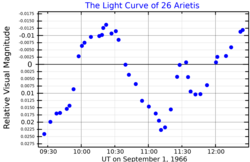| Observation data Epoch J2000 Equinox J2000 | |
|---|---|
| Constellation | Aries |
| Right ascension | 02h 30m 38.41727s [2] |
| Declination | +19° 51′ 19.0917″ [2] |
| Apparent magnitude (V) | 6.10 - 6.15 [3] |
| Characteristics | |
| Spectral type | A9 V [4] |
| U−B color index | +0.102 [5] |
| B−V color index | +0.248 [5] |
| Variable type | Delta Scuti variable [3] |
| Astrometry | |
| Radial velocity (Rv) | +15.0 [6] km/s |
| Proper motion (μ) | RA: +79.814 [2] mas/yr Dec.: −34.746 [2] mas/yr |
| Parallax (π) | 13.7810±0.0831 mas [2] |
| Distance | 237 ± 1 ly (72.6 ± 0.4 pc) |
| Absolute magnitude (MV) | 1.89 [7] |
| Details | |
| Mass | 1.74 [8] M☉ |
| Radius | 2.32+0.11 −0.12 [2] R☉ |
| Luminosity | 15 [7] L☉ |
| Surface gravity (log g) | 3.84 [7] cgs |
| Temperature | 7,430 [7] K |
| Rotational velocity (v sin i) | 186 [9] km/s |
| Age | 1.075 [8] Gyr |
| Other designations | |
| 26 Ari, UU Arietis, BD+19°365, FK5 2172, HD 15550, HIP 11678, HR 729, SAO 92979 [10] | |
| Database references | |
| SIMBAD | data |
26 Arietis is a variable star in the northern constellation of Aries. 26 Arietis is the Flamsteed designation; it also bears the variable star designation UU Arietis. The apparent visual magnitude of this star is 6.14, [5] which, according to the Bortle Dark-Sky Scale, is within the naked eye visibility limit in dark rural skies. The annual parallax shift of 13.78 mas [2] is equivalent to a distance of approximately 215 light-years (66 parsecs ) from Earth. The star is receding from the Earth with a heliocentric radial velocity of +15 km/s. [6]
Michel Breger discovered that 36 Arietis is a variable star in 1969. [11] It was given its variable star designation in 1970. [12] It is a Delta Scuti variable [7] with a variability period of 0.0676 days and an amplitude of 0.010 in magnitude. [13] It is an A-type main sequence star with a stellar classification of A9 V. [4] The star is around a billion years old with 1.74 [8] times the mass of the Sun and 2.32 [2] times the Sun's radius. The star is radiating 15 times the luminosity of the Sun from its photosphere at an effective temperature of 7,430 K. [7]
